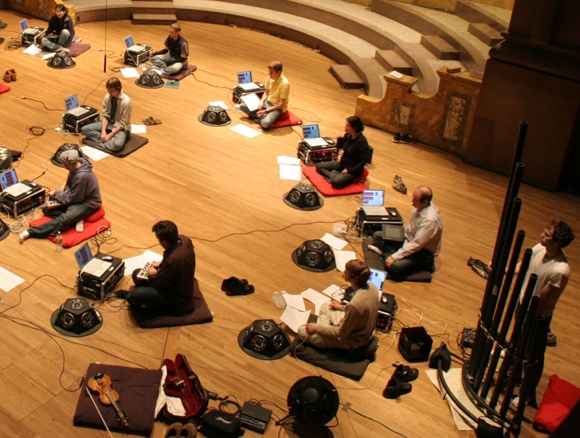
My feature story for Keyboard Magazine on recording live laptop performance is now available online at keyboardmag.com (as well as in the July print issue). When I got the assignment, I think my editor imagined futuristic, sci-fi like network recording, in which audio was streamed entirely virtually from players to a recording server and musicians connected to one another over the ether. Instead, we got just the opposite: quick and dirty solutions for capturing improvisatory computer performance, and intentional efforts to make laptop performances sound more like conventional instrumental ensembles. The case studies:
- The Moscow Laptop Cyber Orchestra hosts laptop jam sessions at the conservatory that bears Leon Theremin’s name. Individual speakers, stereo mic — plus groovy visuals in the background.
- Princeton University’s PLOrk plays with hemispherical speakers so that sound radiates from near the laptop the way it would from a real instrument. Their recording configuration is a little more sophisticated, with not only a stereo pair for the audience but three mics above the stage.
- Share in New York has the toughest challenge of all: a club environment in which anyone can show up with any gear and play. They combine the tried-and-true (old-fashioned analog snakes on the floor) with software tools for standardization (a template in the open source Linux and Mac DAW Ardour).
Check out the full story for details:

One thing we didn’t broach was what to actually play (these ensembles all experiment with everything from alternative controllers to live coding). But the recording question alone turned out to reveal a lot about laptop performance, and how it’s gradually evolving into just music performance.
Also of interest, Craig Anderton talks about the basics of recording your sets live in Ableton Live. The basic idea: record not only the arrangement, but external audio, as well.
This story also turned out to be an interesting demonstration of what can happen when new online sites (like CDM) interface with a traditional outlet (Keyboard, bringing you music making information since 1976). That’s my ultimate hope: that these outlets will make each other better, and each will expand the knowledge of techniques and what (and who) is out there. Less lofty translation: if Keyboard hadn’t asked me to write this up, I might never have gotten around to it, and conversely, if I didn’t have CDM, I would never have hooked up with folks like the Moscow Laptop Cyber Orchestra.
Speaking of which, let us know how you record your sets and even laptop ensembles, and if I missed anything!
Previously:
Laptop Orchestras Proliferate, from Princeton to Moscow